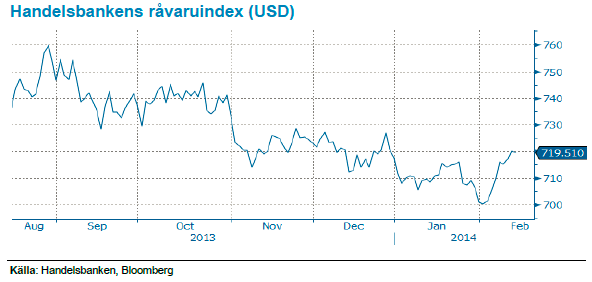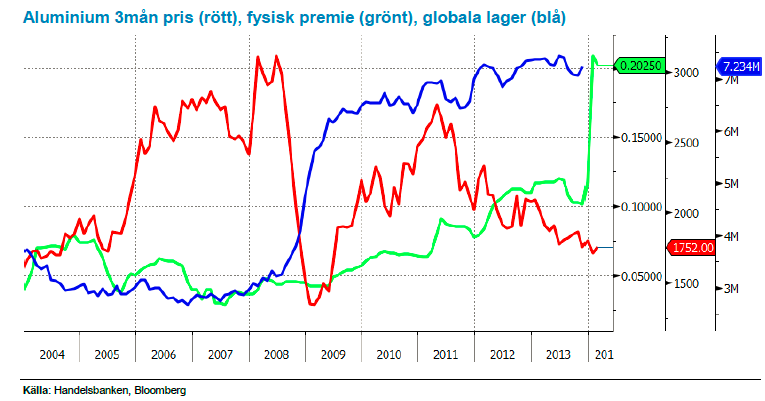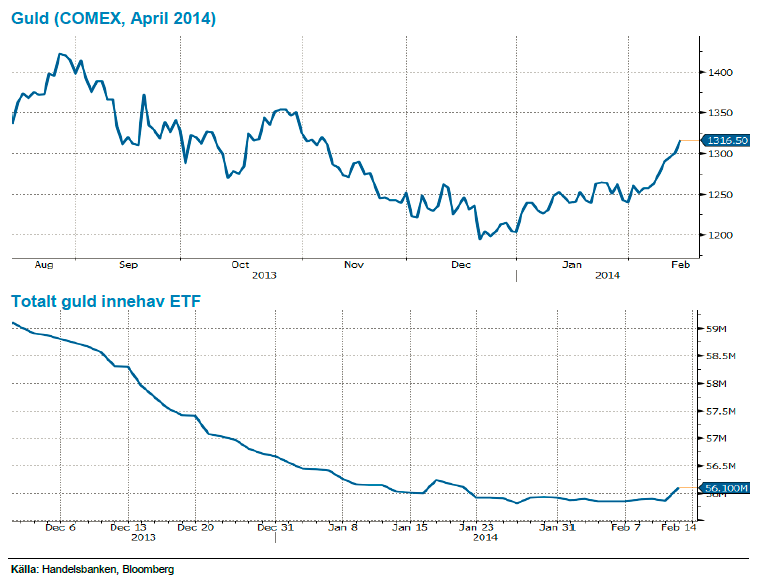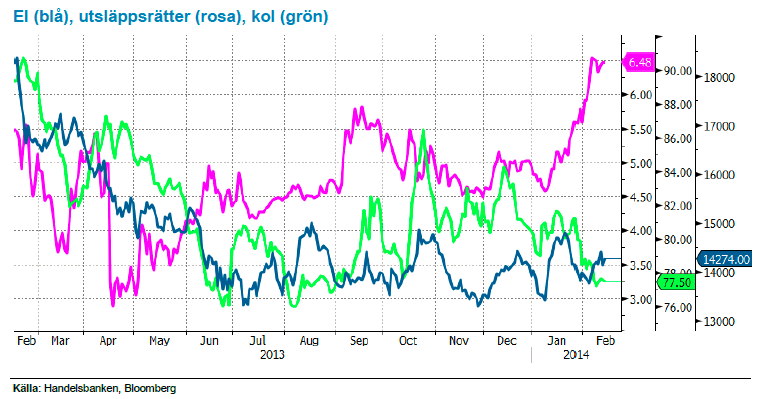Analys
SHB Råvarubrevet 14 februari 2014

Råvaror allmänt: Yrvädret kom en februariafton
 Optimismen i början av året fick sig en törn, men har kommit tillbaka relativt snabbt. Börser i väst har återhämtat den största delen av fallet och marknaden drar slutsatsen att den senaste tidens överraskande svaghet i amerikansk data (ISM och payrolls), är tillfällig. I den mån vädret ligger bakom avmattningen i data skulle effekten kunna bestå även i februari. Vi tror dock att investerare kommer att vara betydligt mer obekväma med en sådan tolkning om både sysselsättningsökningen och ISM skulle ligga kvar på januarinivåer. Därmed blir ISM och sysselsättningsdata än mer avgörande för marknaden i samband med release i början av mars.
Optimismen i början av året fick sig en törn, men har kommit tillbaka relativt snabbt. Börser i väst har återhämtat den största delen av fallet och marknaden drar slutsatsen att den senaste tidens överraskande svaghet i amerikansk data (ISM och payrolls), är tillfällig. I den mån vädret ligger bakom avmattningen i data skulle effekten kunna bestå även i februari. Vi tror dock att investerare kommer att vara betydligt mer obekväma med en sådan tolkning om både sysselsättningsökningen och ISM skulle ligga kvar på januarinivåer. Därmed blir ISM och sysselsättningsdata än mer avgörande för marknaden i samband med release i början av mars.
I samband med Yellens jungfrutal i veckan indikerade hon att betydligt mer än några låga sysselsättningssiffror krävs för att Fed skall avvika från inslagen taper-linje (vilket bekräftade en av hörnpelarna i vår vändning till köp på guld). Oron för tillväxtmarknader finns kvar, men marknaden drar slutsatsen att de länder som är har de tydligaste problemen (Argentina, Turkiet, Sydafrika) är för små finansiellt och realt för att gunga den globala båten.
Förutsättningarna för en amerikanskt ledd global återhämtning är på pappret bättre än på länge. De senaste årens stigande tillgångspriser och kraftiga ihopspreadningar talar för att den sedvanliga feedback-loopen ger en skjuts in i realekonomin. Dessutom är finanspolitiken en mindre motvind jämfört med de senaste åren. Till och med euroområdet har överraskningspotential mot bakgrund av den signifikanta lättnaden i finansiella förhållanden som har blivit följden av ECB:s backstop. I Kina är det dock slagigt, importdata för koppar, järnmalm, soja och olja kom under veckan på 3 års högsta för januari månad. Tillsammans med en motstridig uppgift om starkare än väntad export/import anar vi viss nyårsledighetseffekt i data. Data under mars kommer bli ovanligt viktig, både från Kina och USA.
Basmetaller: Kinas importdata på 3 års högsta
Basmetallerna fortsätter att handlas upp något även denna vecka. Under februari har vårt basmetallsindex stigit med 2,2 %. Importdata för januari från Kina visar på rekordhög import på bland annat koppar. Risk finns dock att den höga siffran har påverkats av kinas nyår då tullverket pappersarbetet forcerats inför nyårsledigheten. Vi väntar med andra ord att februaris import kommer in betydligt svagare.
Väldigt intressant utveckling på aluminium där den fysiska premien (i grönt nedan) skjutit iväg som ett resultat av höga lager (blå kurva nedan 7.234 miljoner ton nedan) / långa köer på grund av de contangoaffärer och börsens svårigheter att lösa flaskhalsarna som vi tidigare skrivit om. Samtidigt ser vi en starkare efterfrågan, framför allt i USA, där flertalet hamnat korta efter att man dragit ned närmare 600,000 ton kapacitet (USA som producerade ca 4.9 miljoner ton 2013 står för 10% av den gloabal produktionen där Kina är ledande med 21.9 miljoner ton rapporterat och uppskattningsvis 2.4 miljoner ton orapporterat. Vi förväntar oss att aluminium stiger något under året men att det stora överskottet först börjar betas av mot slutet av 2015. Såväl Rusal, Alcoa och Rio Tinto har aviserat neddragningar vilket ger stöd för priset.
Låga prisnivåer, exportstopp av oförädlad nickelmalm från Indonesien och det faktum att 40 % av gruvorna går med förlust på dagens prisnivå. Vi tror på: LONG NICKEL H
Ädelmetaller: Ytterligare en bra vecka för guldet
Vi noterar en bra vecka för samtliga ädelmetaller, guldet har t. ex. stigit med drygt 3,2 procent sedan förra veckans brev. Vi är ju sedan ett par veckor nu positiva på ädelmetaller – särskilt guldet – drivet av ett par orsaker. Vårt resonemang – som dessutom mynnade ut i ett Trading Case den 31 januari – baserades på att konsensus blivit negativa på guld (det brukar löna sig att gå emot strömmen), att Feds begynnande åtstramning inte haft negativ påverkan på guldet, och att utflödena ur guld ETF-er verkar ha avstannat. Vidare trodde vi att den uppseglande emerging markets-oron kunde leda till ”säkerhamn” flöden in i guld, och att Indien och Kina nu kan komma att köpa en något större del av den fysiska produktionen.
När vi nu tittar på dessa faktorer så noterar vi att – som nämnts i inledningen av brevet – Yellens tal i veckan, som signalerade åtstramning, inte hade negativ påverkan på guldet denna gång heller, och att flödet till ETF för första gången på väldigt länge varit starkt positivt. Därtill har en återhämtning i den globala riskaptiten – som lett till börsuppgångar världen över, och återhämtning i emerging-valutor – inte heller skapat någon nedgång i guldpriset. Vi är sammantaget fortsatt starka i vår positiva syn efter ytterligare en vecka med positiv prisutveckling.
Efter en lång tid av negativ vy för guldet har vi bytt fot och tror på stigande pris. Vi tror på: LONG GULD H
Energi: Elpriset tyngs av det milda vädret
Det räcker med att titta ut genom fönstret så förstår ni hur resten av elmarknaden resonerar, vädret är just nu den styrande faktorn och prognoserna pekar på fortsatt våta och milda scenarion vilket gör att vi närmar oss den tidigare lågpunkten för Q2-14. Vi har en svag fysisk marknad där spoten överraskar negativt mot slutet av veckan samt en nedskrivning av vattenvärdena i nivå med var brytpriset ligger. Utsläppsrätterna, rosa i graf, som stigit 30 procent under året efter mer konkreta förslag kring att minska överskottet faller tillbaka något samtidigt som kolet, i grönt nedan, handlas oförändrat. Vi behåller en neutral vy i väntan på att någon av ovan nämnda faktorer förändras.
Oljemarknaden handlas oförändrat över veckan då amerikanska arbetslöshetssiffror balanseras av vikande Libyska produktionssiffror, återigen ned till 450kbpd efter protester vid oljefälten, samt torsdagens rapport från International Energy Agency som nu är något mer positiv. IEA rapporten visar att lagren i OECD länderna föll 1.5 procent under förra kvartalet som ett resultat av en ökad efterfrågan vilket i så fall skulle innebära det största kvartalsfallet sedan 1999 för lagren. Tidigare i veckan har även OPEC och EIA reviderat upp sina prognoser för efterfrågan under 2014. På utbudssidan minskar både Irak och Saudi något (9.82 mfpd i december), säkerligen med stöd från Libyen som ändå väntas nå en produktion om 770kfpd under året. Det skulle innebära att reservkapaciteten ökar till 1.92 mfpd vilket är en förbättring från nuvarande ca 1.5 mfpd. Summa summarum, vi står fast vid vår vy att oljan kommer att vara fortsatt köpvärd ned mot 106 med en begränsad potential uppemot 111 dollar och där en positiv rullningsavkastning tack vare terminsrabatten motiverar att ligga kvar.
Vi tror att det kommer ges möjligheter till god avkastning i denna range-baserade handel där oljan är köpvärd var gång den kommer ned på lägre nivåer. Vi tror på: LONG OLJA H
Handelsbankens råvaruindex
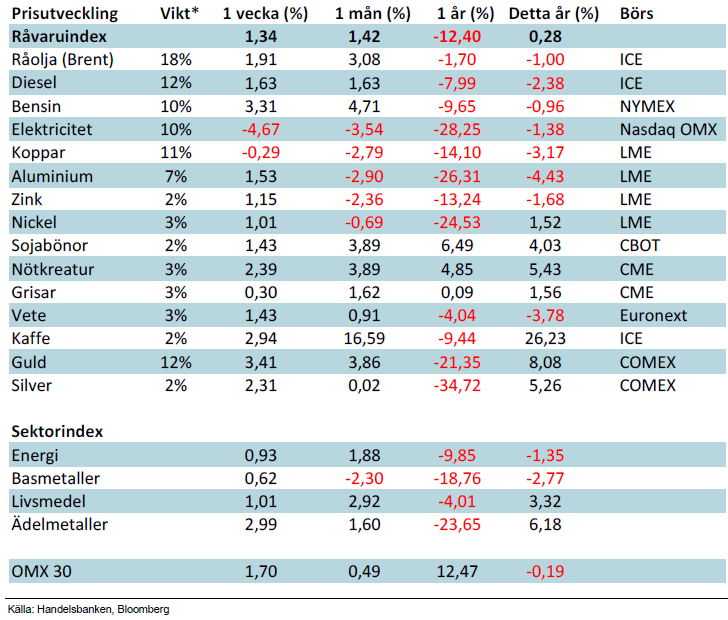
*Uppdaterade vikter från 29 november 2013
Handelsbankens råvaruindex består av de underliggande indexen för respektive råvara. Vikterna är bestämda till hälften från värdet av nordisk produktion (globala produktionen för sektorindex) och till hälften från likviditeten i terminskontrakten.
[box]SHB Råvarubrevet är producerat av Handelsbanken och publiceras i samarbete och med tillstånd på Råvarumarknaden.se[/box]
Ansvarsbegränsning
Detta material är producerat av Svenska Handelsbanken AB (publ) i fortsättningen kallad Handelsbanken. De som arbetar med innehållet är inte analytiker och materialet är inte oberoende investeringsanalys. Innehållet är uteslutande avsett för kunder i Sverige. Syftet är att ge en allmän information till Handelsbankens kunder och utgör inte ett personligt investeringsråd eller en personlig rekommendation. Informationen ska inte ensamt utgöra underlag för investeringsbeslut. Kunder bör inhämta råd från sina rådgivare och basera sina investeringsbeslut utifrån egen erfarenhet.
Informationen i materialet kan ändras och också avvika från de åsikter som uttrycks i oberoende investeringsanalyser från Handelsbanken. Informationen grundar sig på allmänt tillgänglig information och är hämtad från källor som bedöms som tillförlitliga, men riktigheten kan inte garanteras och informationen kan vara ofullständig eller nedkortad. Ingen del av förslaget får reproduceras eller distribueras till någon annan person utan att Handelsbanken dessförinnan lämnat sitt skriftliga medgivande. Handelsbanken ansvarar inte för att materialet används på ett sätt som strider mot förbudet mot vidarebefordran eller offentliggörs i strid med bankens regler.
Analys
Tightening fundamentals – bullish inventories from DOE

The latest weekly report from the US DOE showed a substantial drawdown across key petroleum categories, adding more upside potential to the fundamental picture.

Commercial crude inventories (excl. SPR) fell by 5.8 million barrels, bringing total inventories down to 415.1 million barrels. Now sitting 11% below the five-year seasonal norm and placed in the lowest 2015-2022 range (see picture below).
Product inventories also tightened further last week. Gasoline inventories declined by 2.1 million barrels, with reductions seen in both finished gasoline and blending components. Current gasoline levels are about 3% below the five-year average for this time of year.
Among products, the most notable move came in diesel, where inventories dropped by almost 4.1 million barrels, deepening the deficit to around 20% below seasonal norms – continuing to underscore the persistent supply tightness in diesel markets.
The only area of inventory growth was in propane/propylene, which posted a significant 5.1-million-barrel build and now stands 9% above the five-year average.
Total commercial petroleum inventories (crude plus refined products) declined by 4.2 million barrels on the week, reinforcing the overall tightening of US crude and products.


Analys
Bombs to ”ceasefire” in hours – Brent below $70

A classic case of “buy the rumor, sell the news” played out in oil markets, as Brent crude has dropped sharply – down nearly USD 10 per barrel since yesterday evening – following Iran’s retaliatory strike on a U.S. air base in Qatar. The immediate reaction was: “That was it?” The strike followed a carefully calibrated, non-escalatory playbook, avoiding direct threats to energy infrastructure or disruption of shipping through the Strait of Hormuz – thus calming worst-case fears.

After Monday morning’s sharp spike to USD 81.4 per barrel, triggered by the U.S. bombing of Iranian nuclear facilities, oil prices drifted sideways in anticipation of a potential Iranian response. That response came with advance warning and caused limited physical damage. Early this morning, both the U.S. President and Iranian state media announced a ceasefire, effectively placing a lid on the immediate conflict risk – at least for now.
As a result, Brent crude has now fallen by a total of USD 12 from Monday’s peak, currently trading around USD 69 per barrel.
Looking beyond geopolitics, the market will now shift its focus to the upcoming OPEC+ meeting in early July. Saudi Arabia’s decision to increase output earlier this year – despite falling prices – has drawn renewed attention considering recent developments. Some suggest this was a response to U.S. pressure to offset potential Iranian supply losses.
However, consensus is that the move was driven more by internal OPEC+ dynamics. After years of curbing production to support prices, Riyadh had grown frustrated with quota-busting by several members (notably Kazakhstan). With Saudi Arabia cutting up to 2 million barrels per day – roughly 2% of global supply – returns were diminishing, and the risk of losing market share was rising. The production increase is widely seen as an effort to reassert leadership and restore discipline within the group.
That said, the FT recently stated that, the Saudis remain wary of past missteps. In 2018, Riyadh ramped up output at Trump’s request ahead of Iran sanctions, only to see prices collapse when the U.S. granted broad waivers – triggering oversupply. Officials have reportedly made it clear they don’t intend to repeat that mistake.
The recent visit by President Trump to Saudi Arabia, which included agreements on AI, defense, and nuclear cooperation, suggests a broader strategic alignment. This has fueled speculation about a quiet “pump-for-politics” deal behind recent production moves.
Looking ahead, oil prices have now retraced the entire rally sparked by the June 13 Israel–Iran escalation. This retreat provides more political and policy space for both the U.S. and Saudi Arabia. Specifically, it makes it easier for Riyadh to scale back its three recent production hikes of 411,000 barrels each, potentially returning to more moderate increases of 137,000 barrels for August and September.
In short: with no major loss of Iranian supply to the market, OPEC+ – led by Saudi Arabia – no longer needs to compensate for a disruption that hasn’t materialized, especially not to please the U.S. at the cost of its own market strategy. As the Saudis themselves have signaled, they are unlikely to repeat previous mistakes.
Conclusion: With Brent now in the high USD 60s, buying oil looks fundamentally justified. The geopolitical premium has deflated, but tensions between Israel and Iran remain unresolved – and the risk of missteps and renewed escalation still lingers. In fact, even this morning, reports have emerged of renewed missile fire despite the declared “truce.” The path forward may be calmer – but it is far from stable.
Analys
A muted price reaction. Market looks relaxed, but it is still on edge waiting for what Iran will do

Brent crossed the 80-line this morning but quickly fell back assigning limited probability for Iran choosing to close the Strait of Hormuz. Brent traded in a range of USD 70.56 – 79.04/b last week as the market fluctuated between ”Iran wants a deal” and ”US is about to attack Iran”. At the end of the week though, Donald Trump managed to convince markets (and probably also Iran) that he would make a decision within two weeks. I.e. no imminent attack. Previously when when he has talked about ”making a decision within two weeks” he has often ended up doing nothing in the end. The oil market relaxed as a result and the week ended at USD 77.01/b which is just USD 6/b above the year to date average of USD 71/b.

Brent jumped to USD 81.4/b this morning, the highest since mid-January, but then quickly fell back to a current price of USD 78.2/b which is only up 1.5% versus the close on Friday. As such the market is pricing a fairly low probability that Iran will actually close the Strait of Hormuz. Probably because it will hurt Iranian oil exports as well as the global oil market.
It was however all smoke and mirrors. Deception. The US attacked Iran on Saturday. The attack involved 125 warplanes, submarines and surface warships and 14 bunker buster bombs were dropped on Iranian nuclear sites including Fordow, Natanz and Isfahan. In response the Iranian Parliament voted in support of closing the Strait of Hormuz where some 17 mb of crude and products is transported to the global market every day plus significant volumes of LNG. This is however merely an advise to the Supreme leader Ayatollah Ali Khamenei and the Supreme National Security Council which sits with the final and actual decision.
No supply of oil is lost yet. It is about the risk of Iran closing the Strait of Hormuz or not. So far not a single drop of oil supply has been lost to the global market. The price at the moment is all about the assessed risk of loss of supply. Will Iran choose to choke of the Strait of Hormuz or not? That is the big question. It would be painful for US consumers, for Donald Trump’s voter base, for the global economy but also for Iran and its population which relies on oil exports and income from selling oil out of that Strait as well. As such it is not a no-brainer choice for Iran to close the Strait for oil exports. And looking at the il price this morning it is clear that the oil market doesn’t assign a very high probability of it happening. It is however probably well within the capability of Iran to close the Strait off with rockets, mines, air-drones and possibly sea-drones. Just look at how Ukraine has been able to control and damage the Russian Black Sea fleet.
What to do about the highly enriched uranium which has gone missing? While the US and Israel can celebrate their destruction of Iranian nuclear facilities they are also scratching their heads over what to do with the lost Iranian nuclear material. Iran had 408 kg of highly enriched uranium (IAEA). Almost weapons grade. Enough for some 10 nuclear warheads. It seems to have been transported out of Fordow before the attack this weekend.
The market is still on edge. USD 80-something/b seems sensible while we wait. The oil market reaction to this weekend’s events is very muted so far. The market is still on edge awaiting what Iran will do. Because Iran will do something. But what and when? An oil price of 80-something seems like a sensible level until something do happen.
-

 Nyheter4 veckor sedan
Nyheter4 veckor sedanStor uppsida i Lappland Guldprospekterings aktie enligt analys
-

 Nyheter4 veckor sedan
Nyheter4 veckor sedanSilverpriset släpar efter guldets utveckling, har mer uppsida
-

 Nyheter3 veckor sedan
Nyheter3 veckor sedanUppgången i oljepriset planade ut under helgen
-

 Nyheter2 veckor sedan
Nyheter2 veckor sedanMahvie Minerals växlar spår – satsar fullt ut på guld
-

 Nyheter3 veckor sedan
Nyheter3 veckor sedanLåga elpriser i sommar – men mellersta Sverige får en ökning
-

 Analys3 veckor sedan
Analys3 veckor sedanVery relaxed at USD 75/b. Risk barometer will likely fluctuate to higher levels with Brent into the 80ies or higher coming 2-3 weeks
-

 Nyheter2 veckor sedan
Nyheter2 veckor sedanOljan, guldet och marknadens oroande tystnad
-

 Nyheter2 veckor sedan
Nyheter2 veckor sedanJonas Lindvall är tillbaka med ett nytt oljebolag, Perthro, som ska börsnoteras


